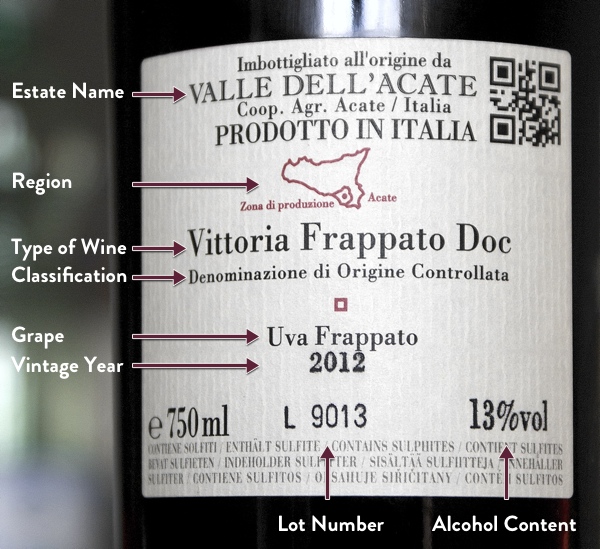Take one aspiring wine buff, a country with arguably the richest wine tradition in the world (we are allowed to be biased here), 20 wine regions (with numerous sub-regions) and over 350 officially documented grape varieties. Allow to mature over a series of articles. Pair with excellent Italian food and never take it too seriously. Welcome to Vini Vino Vinum - ITALY magazine’s new column dedicated exclusively to the adoration of Bacchus’s favourite drink. Exploring Italian wine can be a fantastic journey, so I hope you will be joining us for the trip.
For this article we are not going to get to uncork just yet. A proper wine presentation begins with the label, so we begin by learning to decipher Italian wine labels.

The information on the label will be the Winery Name, the vintage year, the region or area of production. You may at times find the grapes used but that is not a requirement for Italian wines. Of the variety of information on a label the most important is really the classification of the wine. It is the most immediate indication of the type of wine we are about to taste. There are four officially recognised classifications:
1. Vino da Tavola (Table wine) - this is the lowest quality category. Now don’t get me wrong - it does not mean that the wine itself is terrible. However, there are simply much fewer rules about what wine producers can do. They do not need to stick to a specific wine region or report too much about what grapes they are using on the label. You will just get general info such as “red”, “white”, “with bubbles”, etc. One of the most famous brands of table wine in Italy is “Tavernello” - it comes both in bottles and cartons, and their ads (such as one below) try to convince people that it is just as good as the other wines.
2. IGP (Indicazione Geografica Tipica) - The IGT classification is intended for use by wines of better quality than 'vini da tavola'. It indicates the geographic area the grapes come from but does not meet the closely defined requirements of DOCs or DOCGs. However, the less stringent regulations also mean that this is the classification within which wine producers are allowed more freedom to experiment and mix grapes in a way that breaks with tradition. As such, some IGTs are truly excellent wines that simply cannot fall under a DOC or DOCG classification.
3. DOC (Denominazione di Origine Controllata) - DOC wines can only come from specific, well defined areas and can only use specific grapes. The standard was established in 1963 and there are over 300 such wines. The specific areas that define them are often a matter of significant debate, especially when dealing with internationally recognized names such as Montalcino, Montepulciano or Prosecco. The very real "turf wars" in such cases can come down to whether a few hundred meters fall under one or another DOC denomination.
4. DOCG (Denominazione di Origine Controllata e Guarantita) - In this case not only is the geographic area and possible varietals strictly controlled, but the classification is also given in recognition of a wine region that has been producing wines of excellent quality for a significant amount of time (at least five years but typically it is much more than that). The DOCG classification was only introduced in 1982, a result of frustration with too many DOC wines. Therefore, there are only a few dozen DOCG across Italy. The producers undergo stringent controls and the wines have to be bottled in the area of production.
With the label deciphered we move on to actually uncorking. We will start diving into specific wines and some of the history behind wine drinking in Italy in the next column. If you want to make sure not to miss anything, please sign up to the newsletter below.
Alla vostra salute!



















